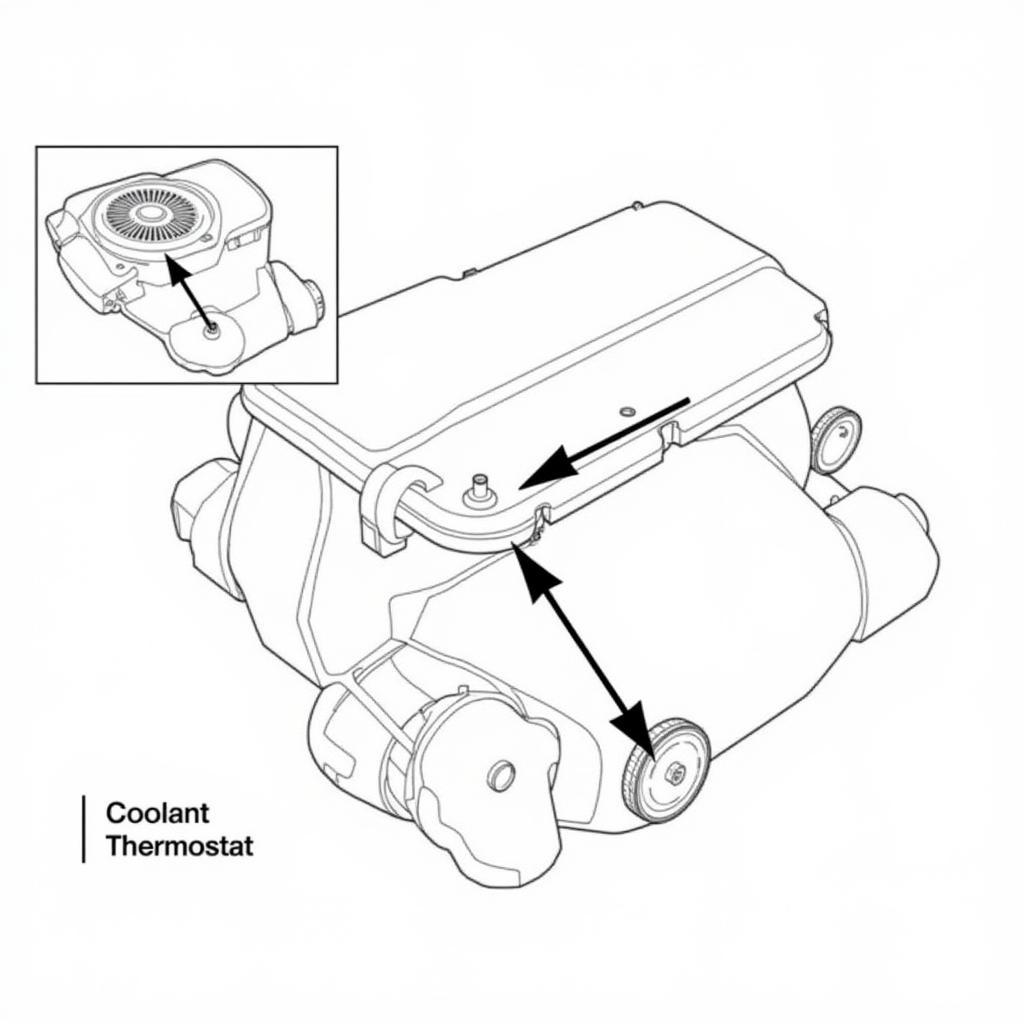The dreaded check engine light can turn even the smoothest Volvo ride into a source of anxiety. When your OBD2 scanner throws up a P0128 code, it specifically signals a problem with your engine coolant thermostat. This means your Volvo engine isn’t reaching its optimal operating temperature effectively. But what does that really mean for you and your Volvo?
This comprehensive guide will delve into the intricacies of the P0128 code, its common causes in Volvo vehicles, and the steps you can take to diagnose and resolve the issue.
Demystifying the Volvo OBD2 Code P0128
The P0128 code, often displayed as “Coolant Thermostat (Coolant Temperature Below Thermostat Regulating Temperature),” essentially indicates that your Volvo’s engine is taking too long to warm up or is consistently running cooler than it should.
Your car’s Engine Control Module (ECM) continuously monitors the engine coolant temperature. It expects to see the temperature rise within a specific timeframe after the engine starts. If this doesn’t happen, and the coolant temperature remains below the thermostat’s designated opening temperature for too long, the ECM triggers the P0128 code.
Why is Reaching Optimal Engine Temperature Crucial for Your Volvo?
Modern Volvo engines are designed to operate within a specific temperature range for optimal performance, fuel efficiency, and emissions control. Here’s why maintaining the right engine temperature is critical:
- Fuel Efficiency: A cold engine consumes more fuel because the fuel-air mixture needs to be richer (more fuel) to burn efficiently.
- Emissions Control: Catalytic converters, responsible for reducing harmful emissions, operate effectively only after reaching a certain temperature.
- Engine Wear and Tear: Running a cold engine for extended periods can increase friction between engine components, leading to premature wear and tear.
Common Causes of the P0128 Code in Volvo Vehicles
While a faulty thermostat is the most common culprit behind the P0128 code, several other factors could be at play, particularly in Volvo vehicles known for their sophisticated engine management systems:
- Faulty Coolant Thermostat: The thermostat might be stuck open or closed, preventing the engine from reaching the optimal temperature.
- Low Coolant Level: Insufficient coolant in the system can lead to inaccurate temperature readings and trigger the code.
- Faulty Coolant Temperature Sensor: A malfunctioning sensor can send incorrect temperature signals to the ECM, even if the coolant temperature is normal.
- Wiring Issues: Damaged or corroded wiring connected to the thermostat or temperature sensor can disrupt communication with the ECM.
Diagnosing the P0128 Code in Your Volvo
Accurately diagnosing the root cause of the P0128 code is crucial for effective repair. Here’s a step-by-step approach:
- Read the Code: Connect your OBD2 scanner to your Volvo’s diagnostic port and retrieve the stored codes.
- Check Coolant Level: Inspect the coolant reservoir when the engine is cold. If the level is low, top it up with the recommended coolant type for your Volvo model.
- Inspect Thermostat Operation: With the engine cold, start your car and carefully feel the upper radiator hose. If the hose remains cold for an extended period after the engine has warmed up, the thermostat is likely stuck open and needs replacement.
- Test Coolant Temperature Sensor: This requires using a multimeter to check the sensor’s resistance at different temperatures and comparing it to the manufacturer’s specifications.
- Inspect Wiring and Connections: Examine the wiring harness connected to the thermostat and temperature sensor for any signs of damage, loose connections, or corrosion.
“When diagnosing the P0128 code, it’s essential to approach it systematically, considering all potential causes,” advises John Anderson, a seasoned Volvo mechanic with over 20 years of experience. “Jumping to conclusions without proper inspection can lead to unnecessary part replacements and wasted time.”
Addressing the P0128 Issue in Your Volvo
Once you’ve pinpointed the underlying cause of the P0128 code in your Volvo, take the necessary steps to rectify the issue:
- Replace Faulty Thermostat: If you’ve determined that the thermostat is the culprit, replacing it is a relatively straightforward repair. Ensure you use a genuine Volvo thermostat or a high-quality aftermarket equivalent that meets Volvo’s specifications.
- Address Coolant Leak: If you find a coolant leak, repair it promptly to prevent further complications. This might involve replacing damaged hoses, clamps, or the water pump.
- Replace Faulty Sensor or Wiring: If a faulty coolant temperature sensor or damaged wiring is detected, replacing these components is essential for restoring accurate temperature readings and communication with the ECM.
Volvo OBD2 P0128: FAQs
Q: Can I continue driving my Volvo with the P0128 code?
While you might be able to drive for a short distance, it’s not advisable to ignore the P0128 code. Driving with a malfunctioning thermostat can impact fuel economy, increase emissions, and potentially lead to more severe engine problems if left unaddressed.
Q: Is it safe to replace the thermostat myself?
If you have mechanical experience and are comfortable working on your car, replacing the thermostat can be a DIY project. However, if you’re unsure about any aspect of the repair, it’s always best to consult a qualified Volvo mechanic.
Need More Help?
Understanding and resolving OBD2 codes can be daunting, especially with a brand as technologically advanced as Volvo. If you need further assistance diagnosing or fixing the P0128 code in your Volvo, don’t hesitate to reach out to our team of expert technicians. We are available 24/7 via WhatsApp at +1(641)206-8880 or email at [email protected].
For more information on other common Volvo OBD2 codes and their solutions, browse our extensive library of helpful articles and resources here on OBDFree. You’ll find comprehensive guides, insightful tips, and expert advice to keep your Volvo running smoothly for years to come.

